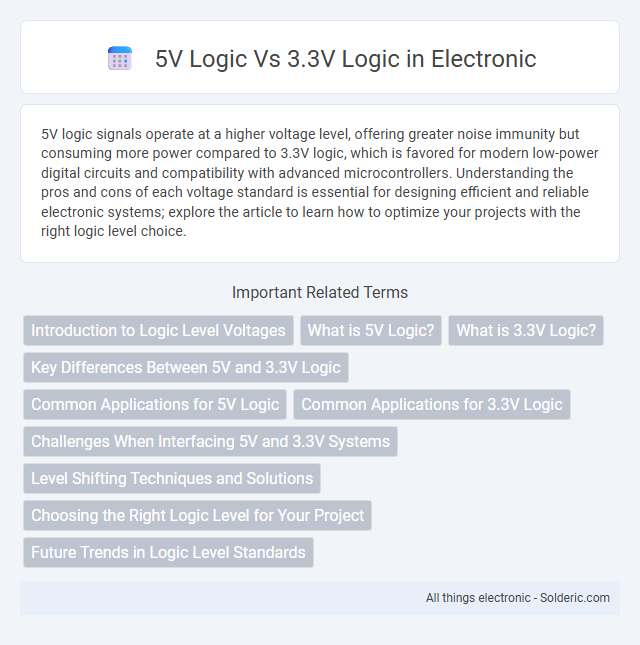5V logic signals operate at a higher voltage level, offering greater noise immunity but consuming more power compared to 3.3V logic, which is favored for modern low-power digital circuits and compatibility with advanced microcontrollers. Understanding the pros and cons of each voltage standard is essential for designing efficient and reliable electronic systems; explore the article to learn how to optimize your projects with the right logic level choice.
Comparison Table
| Feature | 5V Logic | 3.3V Logic |
|---|---|---|
| Operating Voltage | 5 Volts | 3.3 Volts |
| Compatibility | Works with legacy TTL and older microcontrollers | Common in modern MCUs, FPGAs, and low-power devices |
| Power Consumption | Higher power consumption | Lower power consumption, better for battery-powered devices |
| Signal Levels (High) | Typically >2.0V recognized as HIGH | Typically >2.0V but max input at 3.3V |
| Noise Immunity | Better noise margin due to higher voltage swing | Lower noise margin, more susceptible to interference |
| Interfacing | May require level shifters when interacting with 3.3V logic | Needs level shifting when interfacing with 5V logic |
| Application | Industrial, older digital systems | Modern embedded systems, low-power electronics |
Introduction to Logic Level Voltages
5V logic levels use a voltage range where a high signal is typically close to 5 volts, commonly found in older TTL and some microcontroller systems. In contrast, 3.3V logic operates with high signals around 3.3 volts, prevalent in modern low-power and high-speed digital circuits. Understanding the differences in voltage thresholds and compatibility is crucial for interfacing components operating at these distinct logic levels.
What is 5V Logic?
5V logic refers to a digital signal standard where the voltage levels for logic high and logic low are typically 5 volts and 0 volts, respectively. This logic level is commonly used in older microcontrollers, TTL circuits, and many traditional electronic components, providing robust noise margins and compatibility with a wide range of devices. Understanding 5V logic is crucial for interfacing with systems that operate at this voltage level to ensure proper signal transmission and prevent damage to your 3.3V logic components.
What is 3.3V Logic?
3.3V logic refers to digital circuits operating at a voltage level of 3.3 volts for representing binary states, commonly used in modern microcontrollers and low-power devices. This lower voltage level reduces power consumption and heat generation compared to traditional 5V logic, enhancing energy efficiency in electronic designs. Understanding the voltage compatibility between 3.3V and 5V logic is crucial to ensure reliable signal communication and protect your components from damage.
Key Differences Between 5V and 3.3V Logic
5V logic operates with a higher voltage level, providing greater noise immunity and compatibility with older microcontrollers, while 3.3V logic offers lower power consumption and is standard in modern low-power devices. The voltage thresholds for HIGH and LOW signals differ, with 5V logic typically recognizing anything above 3.5V as HIGH, whereas 3.3V logic has a maximum of 3.3V, requiring careful level shifting for interoperability. Understanding these differences is critical for designing circuits that involve mixed-voltage components to prevent damage and ensure reliable communication.
Common Applications for 5V Logic
5V logic levels are commonly used in legacy systems, microcontrollers like the Arduino Uno, and industrial automation where higher noise immunity is required. Devices operating at 5V logic benefit from more robust signal transmission over longer distances or in electrically noisy environments. When integrating with modern 3.3V systems, level shifting ensures compatibility to protect Your components from damage.
Common Applications for 3.3V Logic
3.3V logic is commonly used in modern microcontrollers, FPGAs, and low-power digital circuits where reducing power consumption is critical. It is prevalent in portable devices, embedded systems, and IoT applications due to its compatibility with advanced semiconductor processes and improved noise margin compared to 5V logic. Many sensors and communication modules also operate at 3.3V, enabling seamless integration within low-voltage digital ecosystems.
Challenges When Interfacing 5V and 3.3V Systems
Interfacing 5V logic with 3.3V systems poses challenges such as potential damage to 3.3V components due to higher voltage levels, necessitating level-shifting circuits or voltage dividers for signal compatibility. Differences in input high voltage thresholds can cause unreliable logic state detection, impacting communication accuracy between microcontrollers and peripherals. Careful design considerations must address power supply variations and ground reference disparities to ensure stable and safe operation across mixed-voltage interfaces.
Level Shifting Techniques and Solutions
Level shifting between 5V and 3.3V logic is essential to prevent damage and ensure reliable communication in mixed-voltage systems. Common techniques include using voltage divider resistors, MOSFET-based level shifters, and dedicated level shifting ICs like the TXS0102, each offering trade-offs in speed, complexity, and power consumption. You can choose a suitable level shifting solution based on the signal speed requirements, power constraints, and bidirectional communication needs of your project.
Choosing the Right Logic Level for Your Project
Choosing the right logic level for your project depends on device compatibility, power consumption, and signal integrity. 5V logic offers stronger signal levels and compatibility with older components, while 3.3V logic provides lower power consumption and is commonly used in modern microcontrollers and sensors. Ensuring your devices' voltage thresholds match prevents signal damage and maintains reliable communication in your circuits.
Future Trends in Logic Level Standards
The shift from 5V to 3.3V logic levels has accelerated due to lower power consumption and increased device integration in modern electronics. Emerging standards like 1.8V and sub-1V logic are gaining traction to support ultra-low power applications and high-speed interfaces. Future trends emphasize voltage scaling, enhanced noise margins, and interoperability between mixed-voltage systems in advanced microcontrollers and IoT devices.
5V logic vs 3.3V logic Infographic

 solderic.com
solderic.com